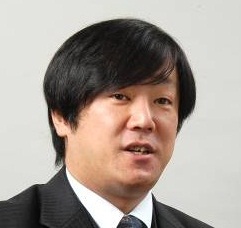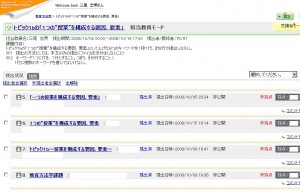03-02. Course N@vi is Drawing Notice for its Far-Reaching Potential in Educational Studies
Tadao Mio
Professor, Faculty of Education and Integrated Arts and Sciences
The key themes in educational technology, Professor Mio’s specialty, are teacher education and curriculum research. The purpose of educational technology is to provide teachers with the means to broaden their teaching options and to solve problems. As an expert in educational studies, Professor Mio was quick to recognize the vast potential of Course N@vi and has adopted it with great effect in many aspects of his own classes.
Able to share the status of report submissions with students
When Course N@vi was first launched in 2007, it was acclaimed for the ability to check whether reports had been accepted.
“There were an increasing number of students who were worried about whether they had properly submitted their reports or whether the reports had been accepted. This is why we tried letting the students check the status of their reports for themselves directly on Course N@vi.”
Course N@vi has the functionality to complete the entire report submission process online with its file uploading function. But Professor Mio has students turn in their reports directly in class and then has his staff members enter in Course N@vi that reports have been submitted as part of the acceptance process. In this way, students can check anytime what reports they have submitted and what reports are still outstanding.
The reason he is insistent on printed reports is “when you have more than 100 students in a class, viewing all their reports on a screen is torturous.” Another reason paper is more convenient is that the professor has students exchange and grade each other’s completed reports in class before handing them in.
A record of report submissions is very important to students because in these classes all reports are required to be submitted before taking the end-of-term examination. “This system is extremely beneficial in classes where there are many submissions or where more weight is placed on submissions.”
Professor Mio also uses the discussion function in classes of 30 to 40 students. One example of this application is having students watch an instructional video and then write their opinions about the video from their computers in the classroom.
In a normal classroom discussion, only a limited number of students get to speak, rendering the other students to mere bystanders. The discussion function has the advantage that all students can participate at their own pace by posting from their computers. And for students who tend to get confused when speaking orally, the discussion function lets them order their arguments while writing. Although these online debates may not reach as deep as face-to-face talks, because they are archived, they can become a resource for re-reading and reconsidering at a later time. And for faculty staff, these discussions are useful when looking back at the effectiveness of teaching materials used in a course.
Trials of on-demand classes for consideration as supplementary classes
Since 2009, Waseda University has been running classes on some national holidays. At the same time, some have voiced concern about the difficulty in securing time for supplementary classes. Professor Mio got the idea of using Course N@vi for on-demand supplementary classes. He tried out his idea on a trial basis last December.
People tend to think of on-demand classes as videos with the teacher conducting the lesson while facing a camera. But Professor Mio prepares transcripts of his regular classes as html-tagged documents and uploads them to Course N@vi. Students, then, instead of coming to campus and listening to the class in a classroom, access Course N@vi from a computer and read the text.
Reading a text usually takes less time than listening to a lecture. Thus, if students are asked to simply read the text from a lecture, which is normally 90 minutes long, their study time will be much shorter. For this reason, Professor Mio pads the text with reference materials and related URLs so that the supplementary lesson involves the same amount of study time as a live lecture in a classroom.
To confirm that the students participated in the class, the students are asked to write comments (reviews) on topics discussed in the class and submission of comments are considered as attending the class.
On questionnaires given to students later, around 60 minutes was the most common answer to the time spent on the class and nearly three in four said they spent either 45, 60, or 75 minutes on the class. Nearly all students answered in the affirmative to the question “were the materials and explanations sufficient for a lesson?”
When asked whether on-demand classes could potentially replace classroom lectures, there were many dissenting opinions, possibly because regular classes in these courses are used for discussions with other students and group work. Nevertheless, although there is no clear comparative data, on-demand classes have been better attended than classroom lectures perhaps because there is more leeway in when the on-demand classes can be taken.
What Professor Mio reads from these results is “even though it’s impossible to replace all live lectures, on-demand classes do have their place as a second-best method of supplementing live lectures in certain circumstances.” He adds: “Undergraduate students aiming to get a teacher’s license cannot attend campus lectures during their practical teaching or nursing care experiences. Posting materials about classes during this period on Course N@vi is expected to help them keep up with the classes when they return from their practical work experience. Course N@vi has many other functions, so by using these together, I think it is possible to run on-demand classes for two or so of the 15 lectures a term.”
Sharing content and teaching materials leads to richer classes
One of the biggest advantages is being able to repurpose content made for on-demand classes. Professor Mio intends to use the topics he’s created this year in future on-demand classes after updating some data and adding other improvements.
The objective of this content is not simply to replace live lectures but, conceivably, to be used as materials for preparing for lessons and reviewing lessons and for in-class exercises and discussions. The professor is also considering using this content as material for specialized courses and graduate school courses on similar topics.
Content created for Course N@vi can also be shared among faculty members. In fact, the professor had a part-time faculty member teaching the same course use content the professor had prepared for this term. Furthermore, in this course, the professor took the data from questionnaires done with mark sheets after each class and uploaded it in PDF format each week as a private document shared with the part-time faculty member to improve each other’s classes. Professor Mio believes that arranging class materials so that other faculty members can view them can be a learning opportunity to enrich classes through mutual critiques (acting as each other’s teaching coach).
“University faculty members have had few chances in the past to receive assessments from their peers. The idea that they should critique each other is a recent trend. In this area as well, I think Course N@vi offers a great utility.”
Course N@vi can also be used to share in-class materials as well as on-demand content among faculty members. “It is more efficient if faculty members create and share teaching materials relying on each other’s areas of expertise. If the time saved is spent on other activities, it can lead to better classes.”
Uploaded materials on Course N@vi are saved for following years. “I can quickly find the prints I used last year. I also use Course N@vi for my own lecture notes, such as what lesson did I teach in which lecture last time, by recording notes that are private to students and other faculty staff.”
Cover absences for practical work experience with Course N@vi
Professor Mio also teaches courses at the Graduate School of Teacher Education, which was launched in April 2008. Compared with other graduate schools, this graduate school for training specialists requires more credits to be completed within two years and more precise guidance. In addition, considerations must be paid to the time required for practical work experience. To compensate for this time, Course N@vi is used extensively. Specific examples include report submissions, discussions, and communications to students. Course N@vi’s information article function is very useful for communicating by email without the faculty staff or students revealing their email addresses.
There is another reason for actively incorporating Course N@vi at the Graduate School of Teacher Education. “The students studying at this graduate school will be the teachers of current posts and future positions. The ability to make use of IT environments will be a critical factor for the next generations of students. So I feel that it is necessary for these students to gain experience in submitting reports and checking their status in a network environment in the process of learning at the graduate school. This idea of training, then, is another reason why we actively incorporated Course N@vi.”
In the beginning, Professor Mio felt some stress when using Course N@vi. “But as I became used to the system, it felt like the burden got lighter. With the addition of more and more functions, the system gradually became easier to use. Of course, I still have a long wish list: I would like to have the flexibility to customize how grade transcripts are attached, I would like the system’s overall response to be faster, and I would like a simple operational manual. I’m really looking forward to the next system upgrades.”
Tips on implementing Course N@vi
“Uploading your materials on Course N@vi acts as a backup for the materials on your hard drive and makes it easier to migrate data when you replace your computer.”
<list of report statuses>
The most appreciated function is the mechanism that allows both the student and the faculty member to check which reports have been submitted.



